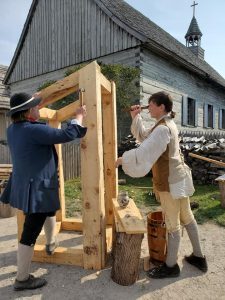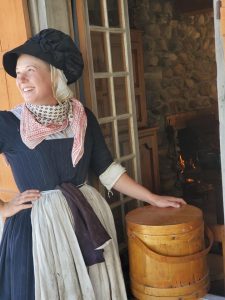During the early years of Michilimackinac’s history not many people settled down at the straits permanently. Most people, especially French soldiers and fur traders, spent a relatively short period at the settlement before moving on. It is somewhat unique, then, for us to find a person that spent their entire life at Michilimackinac. Marie Constance Chevalier was born, lived, and died at Michilimackinac, witnessing huge changes in the community.
Her parents’ sixth child, Marie Constance was born at Michilimackinac in 1719. She likely did not have a formal education, but certainly learned a fair amount about the fur trade business from her parents. They came to Michilimackinac as merchants around 1718, becoming successful and well-known in the area. Growing up it would not have been unusual to see Chinese tea, Caribbean sugar, and textiles from France in her parent’s household.
 Marie Constance married Joseph Ainse in 1741, when she was 22 years old. Joseph was a carpenter and probably came to Michilimackinac specifically to build the church, St. Anne de Michilimackinac. Joseph and Marie had a baby in 1743, but she died soon after birth. The baby’s internment under the newly-built church was the first to be documented in the records. A year later Joseph and Marie Constance had another baby and named him Joseph Louis.
Marie Constance married Joseph Ainse in 1741, when she was 22 years old. Joseph was a carpenter and probably came to Michilimackinac specifically to build the church, St. Anne de Michilimackinac. Joseph and Marie had a baby in 1743, but she died soon after birth. The baby’s internment under the newly-built church was the first to be documented in the records. A year later Joseph and Marie Constance had another baby and named him Joseph Louis.
Marie Constance’s husband died during a trip to Cahokia in 1746. After his death she stayed at Michilimackinac. It is unclear from the records what she did to support herself, but she still had a fairly large family living nearby and likely had significant connections throughout the community. Around that same time, her father also died, leaving her mother to continue in the fur trade business as a widow herself.
During this period of Michilimackinac’s history the fort was expanded and repaired. It was a lively place, especially in the summers when new fur traders were arriving and using the area as a transshipment point for the trade. One of these fur traders was a man named de Quindre who came to Michilimackinac to trade from Fort St. Joseph with a partner named Marin. It is unclear when they met, but by 1749 Marie Constance had a baby and named de Quindre as the father. It is quite clear that they were not married, as he already had a wife and Marie Constance was listed as “the widow” of her late husband Joseph Ainse. She apparently suffered no stigma for having a child while unmarried. After the baby was born, de Quindre left Michilimackinac and ended up living at Detroit with his wife, continuing to work as a fur trader and enlisting in the local militia.
Marie gave birth to a daughter in February 1751, and chose not to identify the father in baptismal records. He may have been Louis Cardin, who married Marie in July 1751. This second husband of Marie Constance was a soldier in the French army. Louis Cardin may have come to the area in 1749 with the commanding officer Faber. Originally from Trois Rivieres, Louis was relatively well-educated. After he finished his service with the military, he and Marie Constance stayed at Michilimackinac. He became the notary and later justice of the peace. Records are unclear, but Louis Cardin and Marie Constance appear to have had at least five children together between 1752 and 1762.
Meanwhile, many changes were taking place at Michilimackinac. The French garrison abandoned the post after the fall of New France in 1760, while British troops arrived in 1761. For the most part, the change in leadership did not significantly alter private life at Michilimackinac. Business continued as usual with some British traders added to the mix.
By 1763, however, tensions between the British and many of the Indigenous people exploded into violence, including the surprise attack and capture of Michilimackinac by the local Ojibwa in June. We don’t know where Marie Constance was or what she experienced during the attack. From other accounts, the French residents were largely left unharmed, sometimes plundering their British neighbors who were killed or captured. The attack happened quickly but left the community in an unstable position. Charles Langlade, another longtime resident of Michilimackinac was put in charge of commanding the post. Langlade was well known and had a close relationship with many of the French residents, including Marie Constance. In 1754, as notary, her husband Louis had signed the marriage contract between Langlade and his wife Charlotte.
After the British returned in 1764 the area settled down and most of the community focused once again on making money in trade. In 1766 Major Robert Rogers arrived as the new commanding officer. Already famous due to his exploits during the Seven Years’ War, as well as his work as an author and playwright, Rogers had had to deal with the complex politics of the Great Lakes, where the British, French-Canadians, and numerous Indigenous nations all worked towards furthering their own agendas. Rogers had to keep the area as peaceful as possible to maintain a British presence, and part of that role included gathering information about the local community.
It was not uncommon for British officers to turn to non-military individuals to do at least occasional intelligence gathering. As Michilimackinac’s permanent community was rather small, numbering around 200 soldiers and fur traders at the time, it is likely that Rogers was introduced to Marie Constance and Louis soon after his arrival at the post.
Rogers asked Marie Constance to go to L’arbre Croche to talk with the Odawa living there to “find out what” they “were about” in April 1767. Rogers sent her out again in May to a village at Cheboygan to speak with the people living there, this time accompanied by a man named Mr. Seeley. When she came back, Rogers recorded that she was able to report that they “had no bad intentions against the English.”
 While her report was not dramatic, it surely was a relief to Rogers to know that the local situation remained calm for the time being. As translators, diplomats and spies, women, especially multi-lingual French women in the Great Lakes, tended to have an advantage over the common British soldier in gaining the trust of their neighbors. People like Marie Constance tended overall to have a more non-threatening status in the community and were often the least suspect. Rogers recognized the value of Marie Constance’s work by paying her and Mr. Seeley £12.18, which was not a small amount. We do not know exactly why she agreed to work for Rogers, but it may have helped her and her husband’s position at the fort.
While her report was not dramatic, it surely was a relief to Rogers to know that the local situation remained calm for the time being. As translators, diplomats and spies, women, especially multi-lingual French women in the Great Lakes, tended to have an advantage over the common British soldier in gaining the trust of their neighbors. People like Marie Constance tended overall to have a more non-threatening status in the community and were often the least suspect. Rogers recognized the value of Marie Constance’s work by paying her and Mr. Seeley £12.18, which was not a small amount. We do not know exactly why she agreed to work for Rogers, but it may have helped her and her husband’s position at the fort.
Marie Constance is rarely mentioned in the historic record after her spy work. She and Louis Cardin continued to live together and work at Michilimackinac until her death in 1775 at age 56. Throughout her life she worked to raise a family, sometimes on her own and operated on occasion for the government. Marie Constance was able to spend her whole life at Michilimackinac by adjusting to shifting family and political conditions. To visit Michilimackinac and learn about the community in which Marie Constance Chevalier lived and worked, check out our website.









